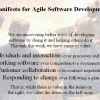 |
The Transparency Experiment: Improving Accuracy and Predictability in Scrum Using the iterative and incremental agile development framework Scrum should help manage product development, but some teams still have difficulty delivering features in a predictable manner. This organization decided to address the mismatch between what was being committed and what was accomplished by doing an experiment in work transparency.
|
|
 |
Reduce Uncertainty in Agile Projects with #NoEstimates Thinking Estimation uncertainty in software projects is often not driven by the difficulty of the problem we are trying to solve, but rather by the health of our codebase, the quality of process, and how much discipline we have in our management practices. If you want to improve your estimates, then agile and #NoEstimates thinking can have the biggest impact on your team’s success.
|
|
 |
4 Balanced Metrics for Tracking Agile Teams Whatever your feelings on metrics, organizations will expect them for your team. You don't want to measure only one aspect to the detriment of other information, but you also don't want to measure too many things and scatter your team's focus. Here are four metrics that balance each other out and help gauge an agile team's productivity, work quality, predictability, and health.
|
|
 |
Back to Basics: Use the Heart of Agile to Frame Your Agile Adoption Somewhere along the way, agile implementations have gotten overblown and unwieldy. Managers and leaders look at all the models and frameworks and think agile adoption is too confusing or not worth the effort. To communicate what agile truly means, we have to simplify the message by getting to the heart of agile: collaborate, deliver, reflect, and improve.
|
|
 |
Agile Managers: Trust Your Team and Encourage Innovation In order to fully embrace agile and create an environment where individuals want to work together as a team, managers have to move from a role of dictation to one of direction and mentorship. Instead of making all the decisions, managers need to trust their team members and empower them to solve problems on their own, innovate, and fail—or succeed.
|
|
 |
Let the Agile Manifesto Guide Your Software Testing Although its values are commonly associated with agile software development, the Agile Manifesto applies to all people and teams following the agile mindset, including testers. This article examines the four main values of the Agile Manifesto and reveals how they can bring agility to test efforts—improving quality for your team and your customers.
|
|
 |
Agile Straight Up: Delivering Value The next time you visit your local watering hole, give some thought to the bartenders and servers and the practices they use. From streamlining team processes to rewarding team performance to always keeping the customer in mind, there are some similarities in the principles used in the agile community and in the service industry.
|
|
 |
Building Team Relationships as an Agile Coach Only by creating a relationship based on trust can agile coaches be effective in aiding teams with an agile adoption. Joel Bancroft-Connors says the best start is actually to do nothing. Spend time observing the team first. This helps you understand the people and processes, which will help you determine the best course of action.
|
|
 |
Practice Soft Skills through Collaboration to Become Truly Agile At the core of agile is the need to effectively communicate and interact with your team members, so it's important for all roles to practice soft skills. However, there is nothing soft about them. Soft skills are probably the most challenging thing you can focus on in your technical career. Rather than struggle to improve by yourself, develop these skills through collaboration.
|
|
 |
For a Successful Agile Adoption, Put Education First Education is a vital ingredient in transformations, and it should be one of the first steps you take in moving to agile. Regardless of anyone’s level of agile experience, everyone should go through the same training because the real value of training isn't the lesson plan; it's the shared experience. Everyone across teams having the same foundation is essential.
|
|
